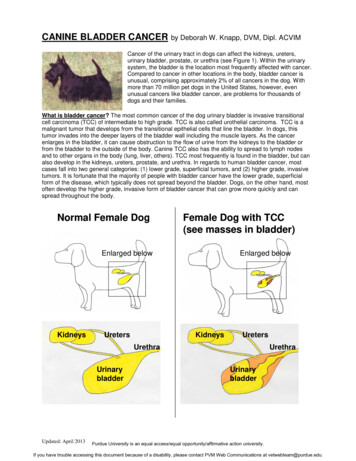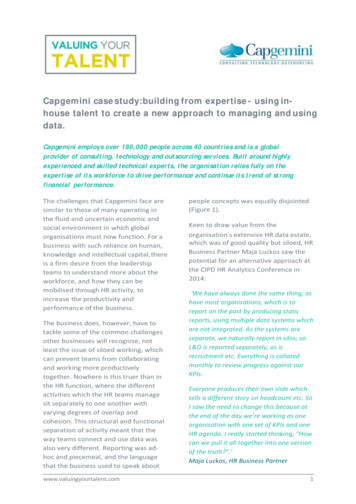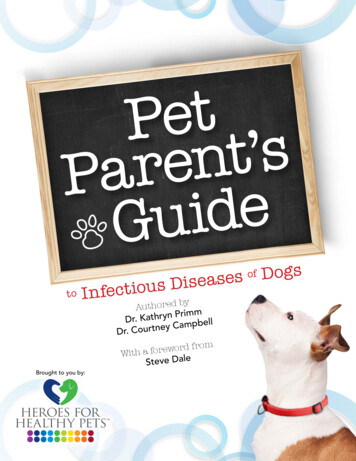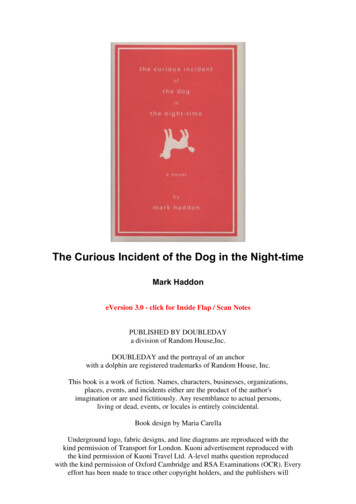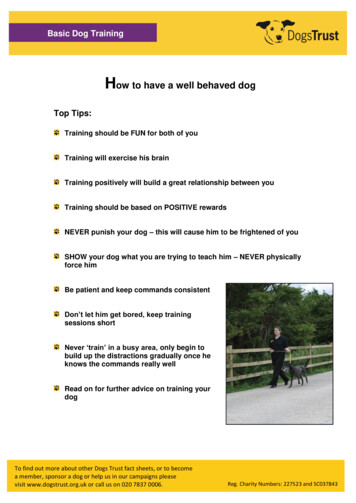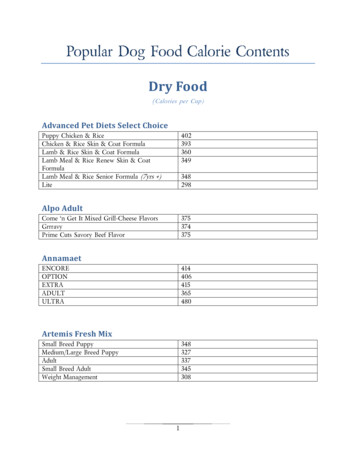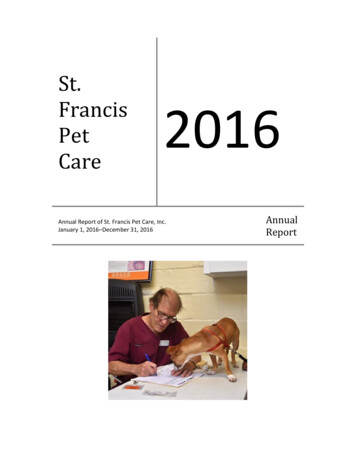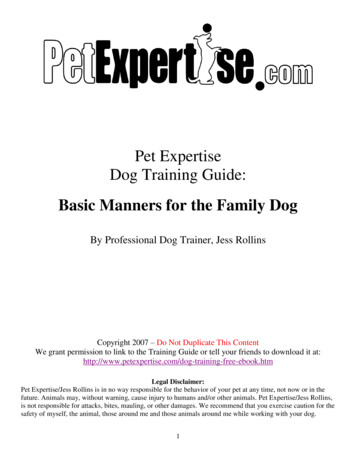
Transcription
Pet ExpertiseDog Training Guide:Basic Manners for the Family DogBy Professional Dog Trainer, Jess RollinsCopyright 2007 – Do Not Duplicate This ContentWe grant permission to link to the Training Guide or tell your friends to download it book.htmLegal Disclaimer:Pet Expertise/Jess Rollins is in no way responsible for the behavior of your pet at any time, not now or in thefuture. Animals may, without warning, cause injury to humans and/or other animals. Pet Expertise/Jess Rollins,is not responsible for attacks, bites, mauling, or other damages. We recommend that you exercise caution for thesafety of myself, the animal, those around me and those animals around me while working with your dog.1
Table of ContentsPart I Teaching the Humans .3 General Care, Suggested Goals.3Socializing Your Puppy .5Strategies to Deal with Problem Behaviors .6Why use Rewards and not Punishments Such as Collar Corrections to Train Your Dog? .7Training Tips .8Frequently Asked Questions About Clicker Training .9The Science of Treats.10Part 2: Teaching the Dog .11 Name Response .11Come .12Drop It .14Leave It .15Sit .16Accepting Handling .18Leash Manners .20Lie Down .23Stay .24Go.25Settle .26Part 3: Problem Solving .26 Nipping .26Jumping Up .27Housetraining .28Barking .31The End – (But you’re Never Done Teaching Your Dog!) .332
Part I: Teaching the HumansGeneral Care, Suggested GoalsCheck the appropriate boxes when you have achieved the goal:DietHigh Quality Food – avoid corn, wheat, by products, artificial preservatives and artificial colors.Fresh Healthy Supplements added (1/4 of daily ration) such as yogurt, fresh meat and vegetables.Avoid junk foodGrooming and Handling Check ListDog is comfortable being touched on feet, ears, tail and this is practiced dailyDog is comfortable with brushing/combingDog is brushed frequently enough to prevent matting of the coat and the skin healthy (once per day –twice per week)Dog is comfortable with ear cleaningEar cleaning is done once per weekDog is comfortable with tooth brushingTooth brushing is done once per weekDog is comfortable with bathingBathing is done once per monthExercise and PlayDog has many toys including a Nylabone, and KongDog is “addicted” to at least one toyDog gets at least 30 minutes of exercise with a person per dayDog gets at least 10 minutes of training per day3
For proper Socialization, make sure your dog is:Dog is comfortable with male and female adultsDog is comfortable with male and female childrenDog is comfortable with people in special circumstances (wheelchair,crutches, etc.)To preventpossessiveness, ensure the following:Dog is comfortable with his food bowl, toys or bed being touchedDog is comfortable with sharing his best friendFor pleasant car ridesDog is comfortable riding in the carDog is Properly restrained in carMiscellaneousAt least 10 hrs good sleep in an adults bedroom.Visits vet regularly, has rabies and distemper vaccination.Neutered or spayed.Proper weight – you should be able to feel your dog's ribs but they should not stick out.Not left outside for long hours.Less than 1 housetraining accident per week.Excess vaccinations or parasite treatments avoided.4
Socializing Your Dog or PuppyOngoing socialization is extremely important to prevent behavior problems. Socialization is especiallyimportant before the age of 6 months, but should also throughout your dog’s lifetime. Gentle socialization playsa huge role in preventing aggression and fearful behavior. Lack of socialization can lead to hyperactivebehavior, barking, shyness and aggression. The younger you begin socializing your dog, the better, but all dogscan be gradually brought into new and even initially fearful situations and learn to enjoy them. Socialization is alifelong process. For example, if your dog does not see any dogs for months or years at a time, you wouldexpect his behavior to change around them when he does finally see them again.How to expose your dog to something new or something he is wary of: Make sure that you remain calm and up-beat and keep his leash loose, if he is wearing one.Expose him gradually to what he is fearful of, never forcing him. Allow him to retreat if he wants too.Reward him for being calm or for exploring the new situation.Try to expose your dog regularly to all of the things and situations you would like him to be able to cope withcalmly in the future. Progress slowly enough so that it is easy for your dog to enjoy the sessions. It will seemlike a lot of time to spend at first, but it will pay off with a well-behaved dog! Below are some examples, but isnot an exhaustive list: Meeting new people of all types, including children, men, crowds, people wearing hats, disabled, etc. Meeting new dogs (due to disease risk, do not bring your pup to areas with lots of dogs until after 4 months– unless it’s a well-run puppy kindergarten). Positive training classes are great for this. Exposure to other pets such as cats, horses, birds Teach him to enjoy his crate Riding in the car (be sure to restrain him using a secured crate or dog seatbelt for safety). Being held, touched all over and in different ways, being bathed and groomed. Visiting the veterinarian’s office, groomer, daycare, boarding kennel. Exposure to loud noises and strange objects (ex. umbrella opening). Exposure to traffic, motorcycles, bicycles, skateboards, joggers. Getting him used to being left alone for a few hours at a time.5
Strategies to Deal with Problem Behaviors (more specific problem solving help is at the end ofthe book).Prevention:Socialization and the creation of a proper living environment are key factors to avoiding problems. Try toimagine all of the elements of his life with humans that he will need to accept to be comfortable with us such asbeing bathed, walking on streets, vacuum cleaners, etc. Teach your dog that such things are not scary by slowlyintroducing him using treats, toys and praise.Another key prevention is to create a means of communication through training. Once you’ve taught the dogthat calm behavior is frequently rewarded and that you control access to all of his favorite things, you havemade a big step towards solving any problems that may come your way in the future.Keep the dog’s environment appropriate for him. Think about the amount of exercise he’s getting, whether hisintellect is being challenged, or if he has enough opportunities to socialize with other dogs and people. Makesure his diet is good and his health is well maintained.Let him feel the confidence that comes from working for a living and the security or having a strong leader. Askhim for a behavior before giving his access to good stuff like the couch or his dinner.Finding Solutions:Many problems reported by dog owners are with behaviors that are instinctual to the dog such as barking,digging, pulling, jumping up, nipping, chewing etc. Others are things that we have accidentally trained into thedog such as barking for attention. It helps to try to understand what is the dog’s motivation for his behavior? Forexample, why won’t your dog come to you when he’s playing with other dogs even though he “knows” what“come” means? If your dog chooses not to come to you sometimes it is probably because coming to you is notmore rewarding than what he is currently doing. To help change that, when you call him, be sure you have agood treat and often times let him continue playing. Begin your practice with short distances.Below are some helpful steps to follow when trying to decide how to help your dog through any problembehavior:1. Consider his environment and health. Is he getting enough exercise - both mental and physical, a good diet,enough sleep, etc? Could the misbehavior be due to a medical problem?2. Prevent the misbehavior until you’ve had time to teach him what you want him to do.3. Make sure that you are not accidentally rewarding the misbehavior. Hint: Any response could be interpretedby your dog as a reward! Ignore the misbehavior or give him a 5 minute time out in a safe but boring area.4. Think of something that you could reward that would replace the misbehavior. For example, teach your dogto sit instead of jumping up to receive affection. Do your best to ask him for and reward the behavior youwant before your dog begins to misbehave. Make sure your reward is of more value to your dog than themisbehavior. Practice the replacement behavior and reward the correct response, ignoring mistakes. Beginwith challenges that are easy for him and then gradually increase the difficulty.5. If your dog’s misbehavior is caused by fear, try to change his dog’s mind about the “scary thing” by pairingit with something he loves. For example: If your dog has a problem with the mail carrier, teach him that themail carrier’s visit is followed by a super treat. He will soon begin to look forward to the mail carriers visits.This technique works best if you also work to prevent him from getting so “worked up”.6. Compromise and be patient!Read more about problem behaviors and how to solve them at Pet Expertise6
Why use Rewards and not Punishments Such as Collar Corrections to Train YourDog?Punishment can cause distrust, fear, injury and aggression. Rubbing a dogs nose in “it” can cause him to avoidgoing to the bathroom in front of you, electric fences can cause him to avoid his yard, and choke collars cancause throat injury and back and neck misalignment.Punishments tend to escalate. If your were to resort to physical punishment, you would find that a light tapwould get your dogs attention at first, but then the contact would tend to get more and more force behind it.Punishment inhibits creativity. If your dog is punished for lying down when asked to sit, he will be confusedand fearful when asked “down”.Punishment has side effects. If his pinch collar tightens every time he sees another dog, he may not understandthat it is his pulling that causes the pinch and may conclude that the other dog is the reason for his distress.Pinch or prong collars have been known to cause aggression towards other dogs.We know better now. In the past we punished children more harshly and have since learned better ways tomotivate them. It is the same with our dogs.Punishment can ruin your relationship with your dog. The act and mindset of looking for errors in your dogsbehavior automatically places you in an adversarial relationship.Training with punishment takes a lot of skill. Most people don’t have this amount of skill. If you have poortiming or use to much force you can really harm your pet physically and psychologically. With reward training,the worst you can do is to be set back a bit or move more slowly until you become more skilled.Punishment causes the learner to focus on avoiding the punishment instead of changing the behavior
Another key prevention is to create a means of communication through training. Once you’ve taught the dog that calm behavior is frequently rewarded and that you control access to all of his favorite things, you have made a big step towards solving any problems that may come your way in the future. Keep the dog’s environment appropriate for him. Think about the amount of exercise he’s getting, whether hisFile Size: 489KBPage Count: 34

